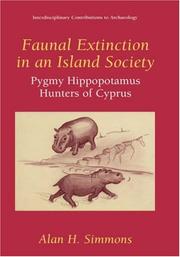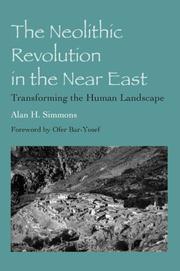| Listing 1 - 8 of 8 |
Sort by
|
Book
ISBN: 1280207159 9786610207152 0306471620 Year: 1999 Publisher: New York, United States : Kluwer Academic : Plenum Publishers,
Abstract | Keywords | Export | Availability | Bookmark
 Loading...
Loading...Choose an application
- Reference Manager
- EndNote
- RefWorks (Direct export to RefWorks)
The multidisciplinary research program at Akrotiri Aetokremnos is important, in my op- ion, for three reasons: two empirical and one conceptual. Quite apart from the archaeology, work at the site is a major contribution to island biogeography, in that the Phanourios sample—certainly the best from Cyprus and probably the best anywhere in the world—has already provided, and will continue to provide, important ecological and behavioral data on these intriguing creatures. Dwarfed island faunas are important to our understanding of the complex factors that shape natural selection in ecologically closed environments over the evolutionary long term. At Aetokremnos, we seem to have the “end” of a long sequence of hippo evolution on the island. With comparative studies of other Cypriot hippo faunas, we should be able to pin down the interval of initial colonization by what were, pres- ably, normal-sized hippos, and—if the other sites can be dated—document the dwarfing process in considerable detail. Aetokremnos would still be a significant paleontological - cality, even in the absence of evidence of a human presence there. While reading the text of the monograph, a number of questions strictly related to the paleontology occurred to me. One was how to model the colonization process. There seems to be little question that the large mammals colonized the island by swimming to it (because, I gather, Cyprus has not been connected to the mainland for roughly 5–6 m- lion years).
Prehistoric peoples --- Excavations (Archaeology) --- Antiquities, Prehistoric --- Aetokremnos Site (Cyprus) --- Archaeology. --- Anthropology. --- History. --- Culture-Study and teaching. --- History, general. --- Regional and Cultural Studies. --- Culture—Study and teaching. --- Annals --- Auxiliary sciences of history --- Human beings --- Archeology --- Anthropology --- History --- Antiquities --- Prehistoric antiquities --- Prehistoric archaeology --- Prehistory --- Archaeological digs --- Archaeological excavations --- Digs (Archaeology) --- Excavation sites (Archaeology) --- Ruins --- Sites, Excavation (Archaeology) --- Archaeology --- Cavemen (Prehistoric peoples) --- Early man --- Man, Prehistoric --- Prehistoric human beings --- Prehistoric humans --- Akrotiri Aetokremnos Site (Cyprus) --- Cyprus
Book
ISBN: 9789925793556 9925793556 Year: 2024 Publisher: Cyprus: Astrom Editions,
Abstract | Keywords | Export | Availability | Bookmark
 Loading...
Loading...Choose an application
- Reference Manager
- EndNote
- RefWorks (Direct export to RefWorks)
This volume is the final report on the excavations conducted by the University of Nevada at Las Vegas at the early Neolithic site of Kritou Marottou Ais Giorkis in the foothills of the Troodos Mountains in western Cyprus. It consists of 19 chapters which variously discuss the site’s chronology, geoarchaeology and palaeoenvironment, excavated features and architecture, lithic finds, human remains and faunal and botanical data, including the results of residue and isotopic analyses of ground stone and plant and animal remains. It is now clear that the Neolithic of Cyprus is as old as that on the mainland. Important recent research, including that presented here, has revolutionised perspectives on the colonisation of the Mediterranean islands and helped to position Cyprus within the wider Near Eastern landscape, providing new insights into the capacity of early seafarers to colonise new territories and a broader context for the expansion of the Neolithic from its continental cores

ISBN: 0306460882 Year: 1999 Publisher: Dordrecht ; Norwell, MA : Kluwer,
Abstract | Keywords | Export | Availability | Bookmark
 Loading...
Loading...Choose an application
- Reference Manager
- EndNote
- RefWorks (Direct export to RefWorks)
Book
ISBN: 9781611321142 161132114X 9781315419732 9781315419701 9781315419718 9781611321159 1611321158 Year: 2014 Publisher: Walnut Creek, California : Left Coast Press,
Abstract | Keywords | Export | Availability | Bookmark
 Loading...
Loading...Choose an application
- Reference Manager
- EndNote
- RefWorks (Direct export to RefWorks)
Over the past decade, evidence has been mounting that our ancestors developed skills to sail across large bodies of water early in prehistory. In this fascinating volume, Alan Simmons summarizes and synthesizes the evidence for prehistoric seafaring and island habitation worldwide, then focuses on the Mediterranean. Recent work in Melos, Crete, and elsewhere--as well as Simmons' own work in Cyprus-- demonstrate that long-distance sailing is a common Paleolithic phenomenon. His comprehensive presentation of the key evidence and findings will be of interest to both those interested in prehistory and those interested in ancient seafaring.
Paleolithic period --- Navigation, Prehistoric --- Paléolithique --- Navigation préhistorique --- Mediterranean Region --- Méditerranée, Région de la --- Antiquities. --- Antiquités --- Material culture --- Navigation --- History --- Sardinia (Italy) --- Paleolithic period - Mediterranean Region. --- Navigation, Prehistoric - Mediterranean Region. --- Material culture - Italy - Sardinia --- Navigation - Sardinia - History --- Sardinia (Italy) - History - to 456
Book
ISBN: 1315419734 1611321166 9781611321166 9781611327700 1611327709 161132114X 9781611321142 9781611321142 9781315419732 Year: 2014 Publisher: Walnut Creek, California : Left Coast Press, Inc.,
Abstract | Keywords | Export | Availability | Bookmark
 Loading...
Loading...Choose an application
- Reference Manager
- EndNote
- RefWorks (Direct export to RefWorks)
Over the past decade, evidence has been mounting that our ancestors developed skills to sail across large bodies of water early in prehistory. In this fascinating volume, Alan Simmons summarizes and synthesizes the evidence for prehistoric seafaring and island habitation worldwide, then focuses on the Mediterranean. Recent work in Melos, Crete, and elsewhere-- as well as Simmons' own work in Cyprus-- demonstrate that long-distance sailing is a common Paleolithic phenomenon. His comprehensive presentation of the key evidence and findings will be of interest to both those interested in prehistor
Paleolithic period --- Navigation, Prehistoric --- Prehistoric navigation --- Eolithic period --- Old Stone age --- Palaeolithic period --- Stone age --- Mediterranean Region --- Antiquities.

ISBN: 0816524424 9780816524426 Year: 2007 Publisher: Tucson University of Arizona Press
Abstract | Keywords | Export | Availability | Bookmark
 Loading...
Loading...Choose an application
- Reference Manager
- EndNote
- RefWorks (Direct export to RefWorks)
Book
ISBN: 0860543889 Year: 1986 Volume: vol 303
Abstract | Keywords | Export | Availability | Bookmark
 Loading...
Loading...Choose an application
- Reference Manager
- EndNote
- RefWorks (Direct export to RefWorks)
Antiquities, Prehistoric --- -Prehistoric peoples --- -Cavemen (Prehistoric peoples) --- Early man --- Man, Prehistoric --- Prehistoric archaeology --- Prehistoric human beings --- Prehistoric humans --- Prehistory --- Human beings --- Prehistoric antiquities --- Prehistoric peoples --- Western Desert (Egypt) --- -Egypt --- Ṣaḥraʼ al-Gharbiyah (Egypt) --- Libyan Desert --- Antiquities --- Antiquities. --- -Western Desert (Egypt) --- Cavemen (Prehistoric peoples) --- Egypt --- Primitive societies
Periodical
ISSN: 18721737 Year: 2007 Publisher: Amsterdam [etc.] Rodopi
Abstract | Keywords | Export | Availability | Bookmark
 Loading...
Loading...Choose an application
- Reference Manager
- EndNote
- RefWorks (Direct export to RefWorks)
| Listing 1 - 8 of 8 |
Sort by
|

 Search
Search Feedback
Feedback About UniCat
About UniCat  Help
Help News
News